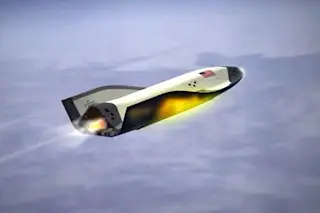The same electromagnetic radiation used to heat up a Hot Pocket could propel a shuttle into space.
A Colorado-based technology company, Escape Dynamics, says initial testing indicates it’s possible to launch single-stage shuttles into orbit using microwaves beamed from the ground. If researchers can make the concept work, it could drastically reduce costs and make it safer to send satellites and humans into space.
Currently, we rely on multistage rockets packed with an extraordinary amount of combustible fuel to propel shuttles into space. The fuel is heavy, making up about 90 percent of the rocket’s initial mass, which makes it expensive to ferry cargo and people into space — it costs anywhere from $5,000 to $50,000 per kilogram of payload delivered into orbit. Furthermore, there’s always a risk when you strap a human into a rocket that relies on powerful chemical combustion.
Escape Dynamics wants spacecraft to shed the weight ...














